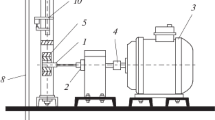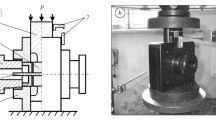Conclusions
-
1.
The mean compressive cycle stresses increase the fatigue crack initiation resistance of the notchen specimens of the rotor steel.
-
2.
The fatigue crack initiation resistance increases with the increase of the prior plastic strain; however, this resistance increases only to the cold working level corresponding to the ultimate strength of the metal.
-
3.
The efficiency of hardening the rotor steel assessed on the basis of the increase of the stress intensity factor remains unchanged in the tests in hydrogen at a loading frequency of 25 Hz.
-
4.
At a loading frequency of 25 Hz, electrolytic hydrogen has no effect on the cyclic cracking resistance (crack initiation resistance) of the rotor steel, both in the initial and hardened conditions.
Similar content being viewed by others
Literature Cited
P. I. Kudravavtsev, Nonpropagating Fatigue Cracks [in Russian], Mashinostroenie, Moscow (1982).
V. S. Ivanova and V. F. Terent'ev, Nature of Metal Fatigue [in Russian], Metallurgiya, Moscow (1975).
A. Ya. Krasovskii “Mechanisms of fatigue crack propagation in metals,” Probl. Prochn., No. 10, 65–72 (1980).
M. O. Levitskii, “Effect of certain structural and service factors on the kinetics of fatigue and corrosion-fatigue cracks in carbon and corrosion-resisting martensitic steels,” Author's Abstract of Candidate's Dissertation, Technical Sciences, Lvov (1976).
M. O. Levitskii, “Equipment for examining fatigue crack growth at a constant stress intensity factor,” in: Information Letter No. 37, Physicomechanical Institute, Academy of Sciences of the Ukrainian SSR, Naukova Dumka, Kiev (1974).
S. I. Mikitishin and M. O. Levitskii, “A method of producing a crack in a cyclically loaded material,” Zavod. Lab.,40, No. 4, 474–475 (1974).
J. J. Blum, “A crack at the edge of a rectangular sheet whose ends are twisted,” Prikl. Mekh., No. 3, 243–246 (1966).
A. M. Shkatova, “Examination of a blank of the rotor for a 1200-MW turbogenerator,” Elektrosila, No. 32, 124–126 (1979).
Additional information
All-Union Scientific-Research Institute of Electrical Engineering, Moscow. Central Scientific-Research Institute of Heavy Engineering, Leningrad. Translated from Problemy Prochnosti, No. 4, pp. 15–19, April, 1986.
Rights and permissions
About this article
Cite this article
Kudryavtsev, I.V., Shokov, N.A. Effect of surface plastic deformation of fatigue crack initiation in a rotor steel. Strength Mater 18, 433–437 (1986). https://doi.org/10.1007/BF01524061
Received:
Issue Date:
DOI: https://doi.org/10.1007/BF01524061




